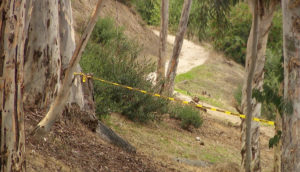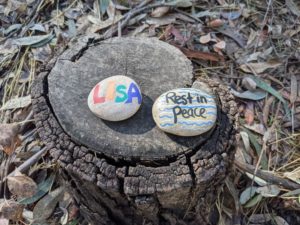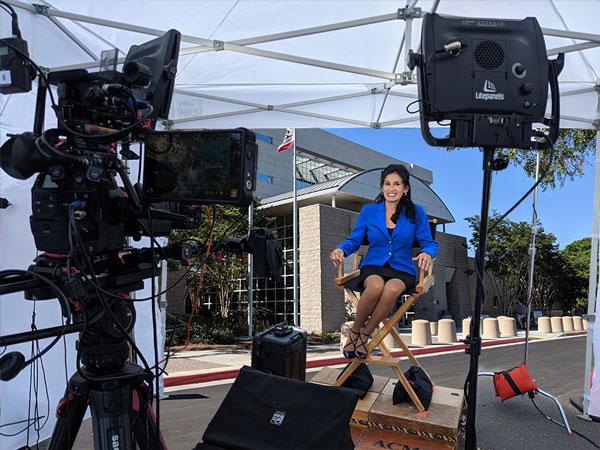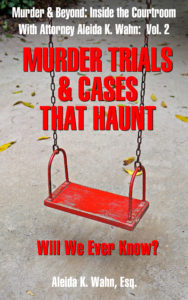
Lisa Thorborg, a Carlsbad hiker, murdered in broad daylight? It simply could not be! But the 911 call came at 11:23 a.m. on November 23, 2020, to report just that. It was a horrifying sight for anyone to see. A lone hiker stabbed to death on a popular public hiking trail in the coastal town of Carlsbad, California. The attack so recent a police detective would later testify the blood had not yet soaked into the ground. Who could have done this terrible act? And why?
The Beloved Lisa Thorborg
For Lisa Thorborg’s family it was the beginning of endless pain. Lisa Thorborg was a 68-year-old widow who had just moved from Oregon to San Diego in May to live with her daughter’s family. The beloved grandmother was looking to meet people and only 15 short days before her death, she wrote a post seeking a hiking partner. On Nextdoor, a social networking site for neighborhoods, she wrote a cheery post, “Hiking anyone? I am looking for a friend to go hiking with. I am a moderate hiker, 68 years of age and I would love some company.” Tragically, she did not have a hiking partner on the Monday morning of November 23rd as she headed out to hike the Hosp Grove Trail, just blocks from her home.
Lisa Thorborg had no idea her life would soon end on a trail she had frequented freely, bringing sudden heartbreak to her family and friends, and terror to a stunned community. As the shocking news was swiftly reported, first of a Carlsbad hiker murdered, then updated with the vibrant photographs and personal information of Lisa Thorborg, police urgently issued a plea for information as they worked around the clock. There was no higher priority then finding Lisa Thorborg’s killer. https://fox5sandiego.com/news/local-news/no-higher-priority-carlsbad-police-give-update-on-search-for-killer/
My Days of Hiking Alone
This story hit me deeply, first for the senseless loss of the life of a beautiful lady, and then because of my own penchant for hiking alone when I am unable to find a hiking companion. This past year, my hiking ventures had become a focal part of my life after a daring friend invited me to sign up for a trek to Mount Everest Base Camp. When my friend first mentioned it, I immediately thought it untenable, but as I researched it further, I decided to challenge myself to do it. Soon I started hiking as many trails as I could, and the idea came to hike California’s Mount Whitney, the tallest summit in the lower 48 states. I felt luck was on my side when I was selected in the lottery for the coveted Mount Whitney hiking permit.
To train at altitude, I traveled to the high sierra mountains and hiked at earnest. Some trails were heavily populated, but on one excursion, I found myself deep in the woods, without a soul in sight for hours. Part of me felt exhilarated, while another part felt afraid, especially when I heard unexpected noise, fearing a bear or a serial killer bent on my destruction. Emerging at last from the trail, I determined my return would be on the main road.
Another time, I traveled to Mount Laguna and once again hiked solo. My first hike was without incident, but the next day, as I hiked, I was suddenly surprised by a deer hunter. His appearance seemingly out of nowhere jolted me and I decided that very day I would never hike alone again, save for trails highly traversed. Just one month later, came the news report of Lisa Thorborg being murdered on the Hosp Grove hiking trail, and I was shaken to my core. That could have been me I thought. Soon I heard an arrest had been made. A juvenile! A seventeen-year-old boy. My heart was filled with sadness.
The Juvenile Court Hearing
As an attorney, true crime writer, and legal analyst of criminal trials, I knew this was a case I would follow. In my work, I seek to not only find out what happened, but why, and what lessons we as a society can learn. You may read my stories at: https://aleidalaw.com/crime/ So, on December 22, 2020, I attended via video feed the juvenile court detention and prima facie hearing. Due to the COVID-19 pandemic the proceeding had to be held virtually, with all parties appearing from various locations. San Diego Superior Court Judge Richard Monroy presided over the hearing, where the prosecutor needed only to provide enough evidence for the court to find sufficient cause for the case to proceed.
A ruling would also be made as to whether the boy would remain in custody in Juvenile Hall or be placed on home detention with an ankle monitoring bracelet. The district attorney’s office had also filed to have him transferred to adult court to try him as an adult, but a hearing had not yet been set.
Although most juvenile court proceedings are closed to the public to protect the privacy of children and to promote juvenile rehabilitation, California law under Welfare and Institutions Code section 676 allows the media and public access under certain circumstances, one of which is when a violent offense such as a murder has been alleged. Strict requirements must be met, and access will be denied if there is a reasonable likelihood the access will harm the child’s best interests.
I filed the required legal documents, and the court granted my request. As the hearing began, the teen appeared in an orange jumpsuit, first without a face mask but later fully masked. Judge Monroy ordered the media to not reveal the teen’s face, requiring tiling of any photo appearing in the press. He did however release the teen’s name, which the defense later outside of court stated was upsetting. For purposes of this story, I will not disclose the boy’s name.
Camera Footage Where Lisa Thorborg Was Discovered Leads to Teen
San Diego Deputy District Attorney Helen Kim called her first witness, Carlsbad Police Detective Josh Dubnis. He testified to the arrest of the teen on December 14, 2020, and to the events leading up to the arrest. On December 2, 2020, nine days after the murder, a trail camera was set up where Lisa Thorborg was discovered. Detective Dubnis watched the footage and on December 3, 2020 at 10:37 a.m. the teen was seen walking the trail holding flip flops in his hand. Detective Dubnis described him as, “Just kind of casually walking.”
On December 5, 2020 at 12:42 p.m. the teen was again seen walking the same trail, again holding flip flops, although this time shirtless and in board shorts.
On December 10, 2020, the teen was again walking, but this time peering over backyard fences, attempting to open vehicle doors, “acting weird and talking to himself.” When an officer tried to speak with him, he ran away. He was soon caught, taken into custody, and transported to an interview room at the Carlsbad Police station.
Teen’s DNA Found On the Shorts of Lisa Thorborg and On Flip Flops Left Near The Crime Scene
Before the teen entered the room, the police wiped down the interview table, and after the interview concluded, a detective swabbed the table to obtain the teen’s DNA. The DNA was sent to the crime lab where it was compared to the DNA found at the crime scene. Detective Dubnis said the teen’s DNA matched the DNA found on the rear left quadrant of Thorborg’s shorts.
Detective Dubnis testified he showed the teen a photograph of Lisa Thorborg and asked him if he had ever seen her, to which the teen responded, “No, he had never seen her before.” “I asked him if there was any chance, he had touched Lisa Thorborg before. He said he had not,” stated Dubnis. When questioned why he was at the trail, the teen responded he hung out at the park, trail, and beach as he liked physical exercise.
Detective Dubnis asked the teen about flip flops that had been found at the crime scene. The teen stated he did leave flip flops, and when questioned why, he indicated he left them as he was not into material goods. He confirmed around the murder he used the trail.
Home Surveillance Footage Near The Time Lisa Thorborg Died
At this point in the hearing, Attorney Kim led Detective Dubnis through home surveillance footage which captured the image of a boy resembling the teen running barefoot on Jefferson Avenue away from the park and trail on November 23, 2020 at 11:25 a.m. He was shirtless, wearing board shorts, and was holding a wadded-up shirt under his arm. Detective Dubnis testified it was believed Lisa Thorborg died at 11:10 a.m. and emphasized it was only 15 minutes later a teen was filmed running away. A license plate reader showed the teen’s grandmother’s car on Jefferson Avenue heading towards the park at 10:21 a.m. and leaving soon after. Detective Dubnis learned it was the routine for the grandmother to drop the teen off at the park where he would hike the trail and then return home on foot.
Cross Examination
On cross-examination, the teen’s attorney Debby Kirkwood, immediately asked if the DNA found was epithelial DNA. Epithelial cells are cells which come from the surface of one’s body, such as skin, and they also line the inside of blood vessels, intestines, and organs. Detective Dubnis said he did not know. Kirkwood continued, “You don’t know how the DNA got there?” to which Dubnis answered, “No.”
Kirkwood next turned to the flip flops, stating Lisa Thorborg could have picked them up herself and then said a witness had seen black flip flops there at 10:00 a.m. (which would have been before the murder). Kirkwood was unable to continue this line of questioning after an objection by attorney Kim but did get Dubnis to agree he did not know when the flip flops were left on the trail. She was not so fortunate though when she asked, “You don’t know who’s flip flops these were?” Detective Dubnis answered firmly he did know, as the teen’s DNA was present on the flip flops, which were found 15 to 20 feet from Lisa Thorborg.
Detective Dubnis then explained there were actually two pairs of flip flops found on the day of the murder. One pair was scattered on the side of the trail and one pair was neatly placed at the trail edge, next to a large log. The teen’s DNA was found on the flip flops neatly placed at the trail edge.
Kirkwood next brought out Lisa Thorborg was not robbed or sexually assaulted. All her personal items were still present on her person. She suffered two stab wounds to her neck, one causing lethal injury to her carotid artery. When Kirkwood asked, “You never found a weapon?” attorney Kim objected, and Kirkwood could no longer continue this questioning. Again, the hearing was not a full trial.
When asked why the teen was arrested, Detective Dubnis answered it was because he was on the trail where Lisa Thorborg died, his DNA was found on her shorts, he was seen on the footage running away from the park near the time of Thorborg’s death, his flip flops were found by the crime scene, and because of his statements.
Kirkwood then moved back to the DNA, bringing out the DNA on Thorborg’s shorts was a mixture from three people and the teen was only an 11% contributor. In concluding her cross-examination, Kirkwood tried to raise the issue Detective Dubnis did not see any cuts on the teen’s hands. Kirkwood also wanted to bring in a witness to testify he did not see any cuts the next day. Attorney Kim objected stating this was only a detention hearing, not an adult preliminary hearing. Judge Monroy agreed and excluded any testimony on this issue, further stating no evidence had been presented regarding cuts. Attorney Kim rested on the prima facie case, calling no further witnesses.
Teen’s Grandmother Testifies He Was Loving and Not Violent, But the District Attorney Had Other Evidence
A Rosy Picture Presented on Direct Examination
After the lunch break, Attorney Kirkwood called the teen’s grandmother, Christie Hernandez, with whom the teen lived. She described her grandson as easy going, loving, and respectful. She said everyone who meets him says, “What a nice, polite man he is.” She testified there was no issue of violence. She detailed her grandson’s routine, saying he would watch the sunrise, work out in his room, have breakfast, do homework, then go to the beach or park. She would drive him to Hosp Grove Park where he would get exercise on the trail and be with nature. She said he ran all the time on the beach.
When asked if she would feel safe if her grandson returned to her home, she said she would and could be his guardian, available to monitor him as she was retired. Her husband would help as well. Kirkwood closed her questioning by asking if she was afraid of her grandson. Hernandez answered she was not afraid, then volunteered her grandson was a hugger, and he would give her “at least five hugs a day for no reason.”
The District Attorney Shows The Teen Had Problems
This rosy picture was soon dispelled under attorney Kim’s cross-examination. The teen had only been living with his grandparents in Carlsbad since September of 2020. Before that he lived with his mother in Oregon, and previously with his grandmother in Hawaii. In Hawaii, he attended the Youth Challenge Academy, a boarding school which Hernandez insisted he was not sent to as a “bad kid” but because he wanted to finish high school and join the military. Kim pressed on, showing the teen twice ran away from the school and was suspended from his Oregon school numerous times for fighting. The last fighting incident was in 2019. He also had unverified, unexcused absences.
Kim then questioned Hernandez about the trial agreement for care of her grandson. Hernandez stated he was living with her on a 6-month trial period, which she explained meant he had to attend school, be doing well overall, and then the period would be extended. She said her grandson attended an on-line home school. Kim questioned if she was aware two days after her grandson’s arrest his mother called the school asking to transfer him to Oregon.
As the cross-examination wound down, the teen’s exercising was again addressed. Hernandez repeated how her grandson was very into health and found good exercise on the trail. She denied he did martial arts but said he did use a broom in exercising and had a plastic sword. When Kim asked whether there was a weapon her husband had that he liked, Kirkwood objected. Judge Monroy shut down this question stating it was beyond the scope of the hearing.
Was There a Secondary DNA Transfer Between the Teen and Lisa Thorborg?
Kirkwood next called Suzanna Ryan, a forensic DNA consultant and analyst. Kirkwood’s main objective was to raise alternative explanations for the teen’s DNA on Lisa Thorborg’s shorts. Kirkwood asked Ryan if epithelial cells would be present on a log if the teen sat upon it. Ryan testified a transfer could occur. Kirkwood asked if someone were running and sweaty, if DNA transfer would occur. Ryan answered, “Yes,” adding the sweat would increase the transfer. Finishing her questioning, Kirkwood asked Ryan, “If a second person sat on the log, could transfer from the first person occur?” Ryan answered, “Yes,” stating a secondary transfer could occur.
Earlier in the hearing, Kirkwood attempted to ask Detective Dubnis about the teen walking upon logs, but attorney Kim objected, and the questioning was immediately halted. Does the line of questioning with Ryan and Detective Dubnis give a glimpse of what the defense strategy will be at trial? A secondary transfer as an innocent explanation for the DNA. A scenario where the teen, who grew up in Hawaii and loved to walk barefoot, walked on a log which Lisa Thorborg later sat upon, accounting for the DNA transfer to the rear of her shorts. Or a scenario where the two simply sat on the same log? Only time will tell what defense will be offered.
Defense Calls Great Uncle Who Could Serve as Custodial Caretaker
Kirkwood called the teen’s great uncle who testified he was a retired Los Angeles Sheriff with over 30 plus years of experience. He stated he could serve as a custodial caretaker if the court would grant release. On cross-examination, Kim showed he did not know much about the teen’s life. He confirmed he did not know the teen was sent to the Youth Challenge Academy, he twice ran away, had suspensions in Oregon, and unexcused school absences.
Attorney Kirkwood Argues the Prosecution Failed to Prove Prima Facie Case
Debby Kirkwood stated the prosecution had failed to prove a prima facie case. She told Judge Monroy Detective Dubnis testified the police arrested because of the DNA, but the DNA could have come from a log she argued. She questioned if her client had committed the murder, why he would return to the trail day after day. She said it was his “habit and custom” to run the trail and that is why he was there. “He’s not there to stab old ladies in the neck,” she said forcefully. Neither was there a sexual assault or robbery, and her client had no history of violence or use of weapons she declared.
Judge Monroy’s Order
Judge Monroy found the prosecution met the burden for a prima facie case, stating sufficient cause existed to believe the teen committed the crime against Lisa Thorborg. He ordered no release due to the serious nature of the crime. The case will proceed forward with a readiness conference on January 25, 2021.
As the case moves forward, the questions remain, “Did this boy commit this horrible murder?” And if so, why? Why was Lisa Thorborg murdered on a beautiful hiking trail that seemed so safe? Why did Lisa Thorborg, so beloved and kind, have to die? Or is this juvenile innocent as his attorneys proclaimed to the media and the real killer is still out there?
Photos Taken By Aleida in January 2021





About Aleida K. Wahn, Esq.


I am an attorney, award-winning true crime writer, and legal analyst of criminal cases. I cover criminal trials and write stories and books about compelling, gripping, and unforgettable cases that impact our world. I take you into the courtroom in high-profile murder trials, rape cases, crimes of passion, cases involving mental illness, deviant behavior, and more. I have a deep passion for true crime, criminal law, and all aspects of the criminal justice system. I have appeared as an expert on true crime shows, including “48 Hours,” “Snapped,” "Peacock TV's Tik Tok Star Murders," and “The Dead Files,” and provided legal analysis on high-profile criminal trials on Court TV, the Law & Crime Trial Network, Fox 5 News, ABC 10 News, and KUSI News. I also create and host shows with the Del Mar Television Producers Group, addressing criminal justice and social issues in recent criminal trials.
I provided my insight and legal analysis on Court TV and the Law & Crime Trial Network of the high-profile trial of former NFL star Kellen Winslow Jr. It was a trial that captured the nation as the heralded ex-football star with fame, fortune, and a famous name stood accused of multiple rapes and other sex crimes involving five women. As the trial delved into shocking facts, complicated legal issues, and unexpected twists and turns, I was there for every minute. After the trial, I wrote a book on the case, going behind the headlines to share the extraordinary details of what happened inside the courtroom. Judging Winslow Jr.: From NFL Star to Serial Rapist? Inside the Shocking Rape Trial of Kellen Boswell Winslow II is now available on Amazon.
I am passionate about telling true crime stories, as these penetrating stories have the power to move us all, while highlighting societal issues which need to be addressed. I have personally seen the human devastation which is present in each trial and believe there is a lesson to be learned in every single case. It is through awareness and examining critical issues society can effect change and even make new laws. To learn more, please visit: https://www.aleidalaw.com.
Read about the gripping and unforgettable trials that I have covered in my latest books:






